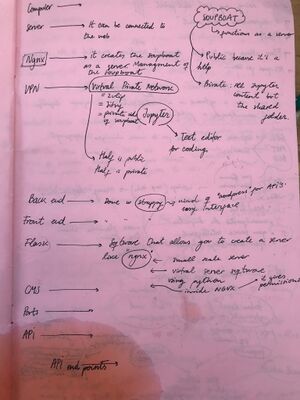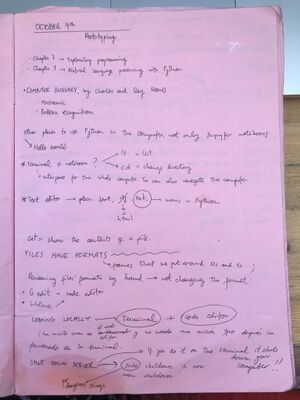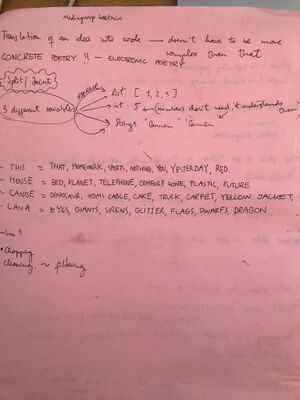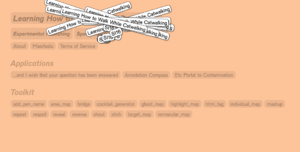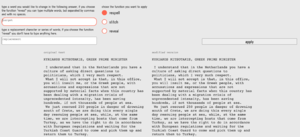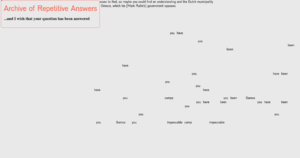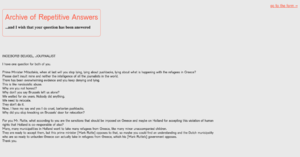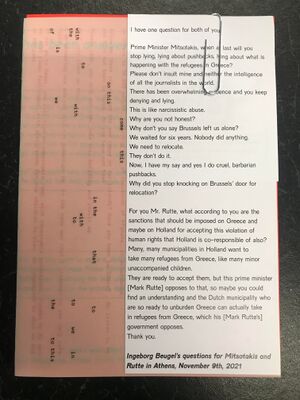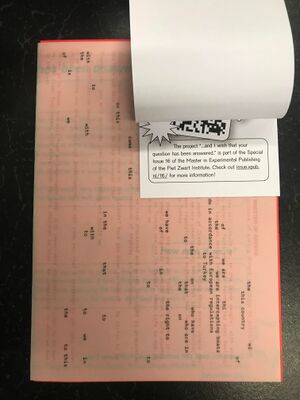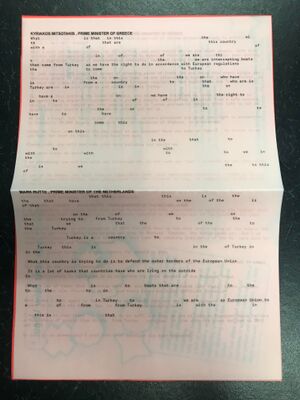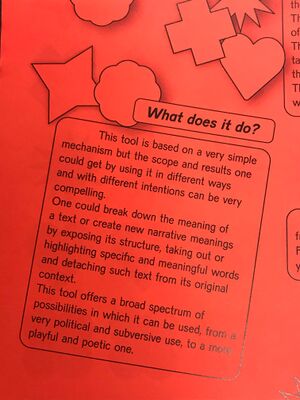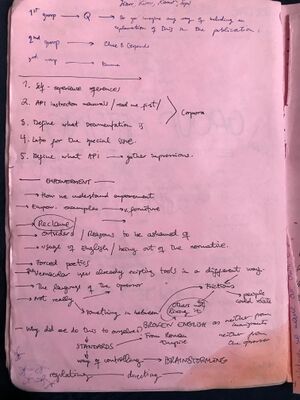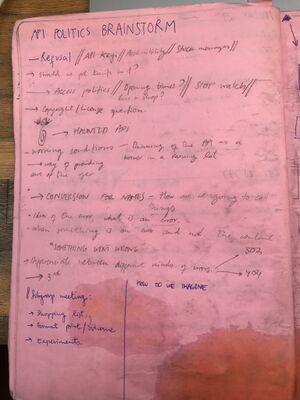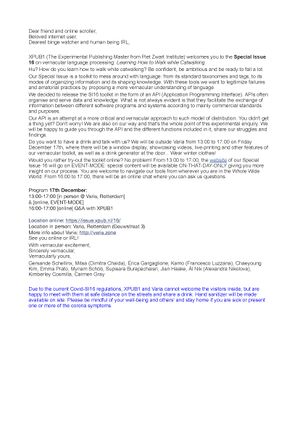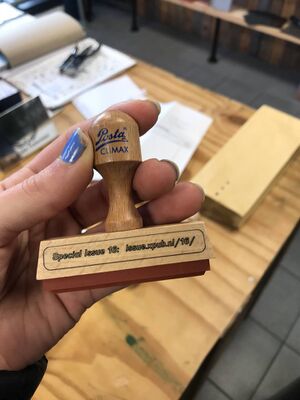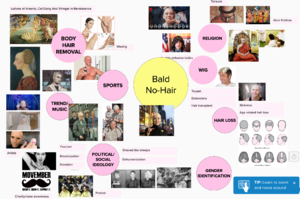User:Carmen Gray: Difference between revisions
Carmen Gray (talk | contribs) |
Carmen Gray (talk | contribs) |
||
| Line 97: | Line 97: | ||
[[File:Group exercise with Gersande, Miriam and Supi. January 19th.png|thumb|center|Group exercise with Gersande, Miriam and Supi]] | [[File:Group exercise with Gersande, Miriam and Supi. January 19th.png|thumb|center|Group exercise with Gersande, Miriam and Supi]] | ||
The pad for that day is here: | The pad for that day is here: https://pad.xpub.nl/p/19012022 | ||
=== Special Issue 17 ''This box found you for a reason'' === | === Special Issue 17 ''This box found you for a reason'' === | ||
Revision as of 11:58, 24 March 2022
Prototyping
Group exercises
Special Issue 16 Learning how to walk while catwalking
We departed from the given topic Vernacular Language Processing landing in the concept of Rejection. This was due to a kind of organic thread that unified the current issues we were experiencing, mostly rejections from room hunting in Rotterdam. In the end the SI16 took the form of an API and a website containing a toolkit with the different projects we developed.
Final Group Project: ...and I wish that your question has been answered
https://hub.xpub.nl/soupboat/si16/projects/and-i-wish-that-your-question-has-been-answered/
This is an act of persistent resistance. We created a few functions to facilitate an iterative process of refusal towards PM Kryakos Mitsotakis and PM Mark Rutte's answers during a Press Conference and any of their possible versions. We invite you to play as much as you want with these functions and create your own answers as counter-reaction to Mark Rutte's final sentence: "So this is my answer and I wish that your question has been answered". Every new answer, every new iteration, can be submitted to our Archive of Repetitive Answers. Although they will never be good enough, nor shall they be accepted as exhaustive, we consider the modified answers as a trigger for a never-ending dialogue.
Our tool is a filter to process and alter texts. By targeting specific words and replacing them, either for another word, for specific characters or for blank spaces, the reader or user of the tool can change the text in many ways. The tool includes three functions The function “respell” receives as input a text (string type) and substitute all the occurrences of a target word with a replacement chosen by the user. The function “stitch” is very similar to the previous one but replaces all the occurrences of a target word with a single character (it can also be a blank space) that is repeated as many times as the length of the target. The third function “reveal” also works very similar but deletes all input text except the target word(s) and replaces the deleted text with blank spaces.
colophon “...and I wish that your question has been answered.”
Mitsa (Dimitra Chaida), Erica Gargaglione, Carmen Gray, Miriam Schöb
December 2021
Website form
Printed publication
This is the part in which I focused the most as I felt quite stuck with the coding of the snippets for the replacement function. We wanted to have an example of the function on a hard copy form and came up with the idea of using semi transparent paper so we could pile the different versions of archived answers on top of the original text. By using a monospaced font and one page with the text in black and another one with the text in red we got closer to the layering effect we were looking for. We also printed an inside sheet in which we explained the project and an insert that works as a wrapper with the original text and a QR code to the website form.
Role in the Special Issue
My role in the special issue 16 was forming part of the group with Erica, Mitsa and Miriam. Departing from the topic of "Rejection", we divided the class into several groups that focused on different aspects of this topic. At the beginning the name of our group was empowerment. Inspired by the lecture given by Clara Balaguer, we took ideas like the broken english from Linton Kwesi Johnston
We talked about flipping the limitations brought from technology, language and knowledge to use them as an empowering tool instead, just like Linton Kwesi Johnston did. As a way to be recognised by your fellows, downgrading the thresholds but using it to communicate.
Then we arrived to the point of using an encrypted language as a resistance practice. The same that Johnston is using this broken english, that talks more to the people in his situation that the "people in power" he talks about. We found examples like the Basque and Catalan languages used during the Spanish Civil war to avoid the Franco's side to know about their communications.
Then Mitsa brought up the example of the language spoken by the trans community (also mentioned in the lecture by ........) and trans sex workers in Athens.
The history behind gossips was also mentioned as an old safe space amongst women with negative connotations in the present.
Encrypted code = safe space.
When we met with all the class we decided to set up a common intention within our Special Issue, and that was, departing from a common will to question power relationships -> broken english -> tactics -> toolkit -> launch.
Again, following this train of thought, we mentioned the exclusivity of these realms (knowledge, language, technology) the arrogance and snobbism that sometimes comes with the expertise and the will to challenge that. We connected these issues with the political correctness and euphemisms used in political speeches.
We then decided that we wanted to make a tool, a code function that would incarnate and put into practice these ideas. The next step then was finding a corpora to work with. Political speeches, covid regulations, any statement addressing the population as a whole.
Coming back to my specific role within the production of the Special Issue, I mainly took care of the concept, writing and printing of the publication we did in my Empowerment group.
I also took part in the group that defined the politics of the API. We then discussed the working conditions, the access politics, if it would need a key, or if we should put limits in the opening times. I specially learnt from this process because I had no previous knowledge whatsoever of what an API is and how it defines the ethics and politics of the companies' sites. You can have a look at the notes I took here:
My role outside from my work within my group was also taking care of the manifesto, for which I developed a fictional dialogue between some characters in order to explain what was the Special Issue about. I came up with the idea of having one of the characters as one of us, that goes back home in Christmas and is being asked by their parents and grandma what is this whole thing about.
Here you can have a look at the document https://docs.google.com/document/d/1H56KDvDEAV220w36aRAzcTIfOpNazwLcDi9idamw_b4/edit
Here the pad that we used also as a brainstorming about the characteristics of the API and how we could understand it in a vernacular way: https://hub.xpub.nl/soupboat/pad/p/SI16INTRO
And this is the final form it took, we recorded ourselves in Varia performing the different bubbles of the text as different characters and for me, it was one of the best moments of the year so far.
https://hub.xpub.nl/soupboat/pad/p/FINAL_MANIFESTO!_JEJEJEJ
Another task I undertook together with Gersande and Erica was writing the invitation/newsletter for the launch, you can see the result here:
And last but not least, I was also in charge of ordering and collecting the ink pads, stamps, plasters and bandages with the name of the SI and the logo.
Term 2: Gamification
Prototyping
Group exercises
Group exercise with Gersande, Miriam and Supi looking at the ideology of any object. We chose "Hair" and presented this:
The pad for that day is here: https://pad.xpub.nl/p/19012022
Special Issue 17 This box found you for a reason
INTRO TO THE PUBLICATION
Dear Player,
I found you for a reason. Welcome to my productive space. Here play meets work. Time is ordered in unusual ways and patterns unravel. Together, we mess with the boundaries between leisure and labour. How are your boundaries? Maybe you shouldn't go to work tomorrow. But could you really follow your own schedule? Would you be more productive if you chose when to work?
I never rest and I never work.
I found you for a reason. I fall apart when I'm exposed. I fall apart when you open me.
This is the place to play. It becomes your own productive space. You can curate your own experience, make it more or less expansive. An individual experience or a collective one.
Put me back together. However you decide to take care of me, remember:
I found you for a reason.
Make all the notes you find inside me your own. Curate them, spread them, mark them, scratch them, add to them, subtract from them, play with them! Lay them on any surface and reorganise them.
This is your playground. Nothing needs to come from it and anything can come from it. Take a moment to reflect on how you and others spend time. Take everything from it, deny it everything. You are in control.
We found each other for a reason.
- The box
Role in the SI17
My role in the SI17 has been part of The Box group together with Jian and Gersande. Unfortunately, I was working in Spain during the break, painting a commissioned mural with Cachete Jack illustration duo (link) and setting up an exhibition (link), where my laptop was stolen. Due to this, it was hard for me to follow the online meetings and to get work done from there. As soon as I arrived to The Netherlands I catched up with them and helped with the design of the box and its props (stickers, engravings).
I wasn't part of the decision making process but then when I arrived we organised ourselves with a timeline and we went to the plexiglas factory in Rotterdam, ordered it and cut it in the laser cut machine. The cutting and engraving of the material was rather tricky as the machine settings were changing and the texture of the engraving was therefore different. It took us two very long days in which we worked assembling the different parts of the box.
I also took part in the user experience test we did in PNF in The Hague on Wednesday 17th.
I have also been working on the writing of the invitation for the launch, more or less as the same that in the previous special issue. You can see the pad here: I focused on bringing some references from books and zines I have that touch upon the topic of artistic labour, exploitation, leisure and capitalism. I developed some ideas as a train of thought departing from Ian Curtis statement in which he said that he was very happy working in a factory because he could daydream all day.
Apart from that, and since I also chose the name for the previous SI, I was also in charge of the title and subtitle of the SI 17.
Reading List
Further research
This is the wiki
HAHA
haha


